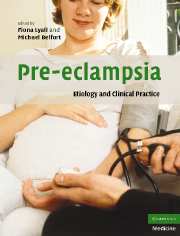Book contents
- Frontmatter
- Contents
- List of contributors
- Preface
- Part I Basic science
- 1 Trophoblast invasion in pre-eclampsia and other pregnancy disorders
- 2 Development of the utero-placental circulation: purported mechanisms for cytotrophoblast invasion in normal pregnancy and pre-eclampsia
- 3 In vitro models for studying pre-eclampsia
- 4 Endothelial factors
- 5 The renin–angiotensin system in pre-eclampsia
- 6 Immunological factors and placentation: implications for pre-eclampsia
- 7 Immunological factors and placentation: implications for pre-eclampsia
- 8 The role of oxidative stress in pre-eclampsia
- 9 Placental hypoxia, hyperoxia and ischemia–reperfusion injury in pre-eclampsia
- 10 Tenney–Parker changes and apoptotic versus necrotic shedding of trophoblast in normal pregnancy and pre-eclampsia
- 11 Dyslipidemia and pre-eclampsia
- 12 Pre-eclampsia a two-stage disorder: what is the linkage? Are there directed fetal/placental signals?
- 13 High altitude and pre-eclampsia
- 14 The use of mouse models to explore fetal–maternal interactions underlying pre-eclampsia
- 15 Prediction of pre-eclampsia
- 16 Long-term implications of pre-eclampsia for maternal health
- Part II Clinical Practice
- Subject index
- References
3 - In vitro models for studying pre-eclampsia
from Part I - Basic science
Published online by Cambridge University Press: 03 September 2009
- Frontmatter
- Contents
- List of contributors
- Preface
- Part I Basic science
- 1 Trophoblast invasion in pre-eclampsia and other pregnancy disorders
- 2 Development of the utero-placental circulation: purported mechanisms for cytotrophoblast invasion in normal pregnancy and pre-eclampsia
- 3 In vitro models for studying pre-eclampsia
- 4 Endothelial factors
- 5 The renin–angiotensin system in pre-eclampsia
- 6 Immunological factors and placentation: implications for pre-eclampsia
- 7 Immunological factors and placentation: implications for pre-eclampsia
- 8 The role of oxidative stress in pre-eclampsia
- 9 Placental hypoxia, hyperoxia and ischemia–reperfusion injury in pre-eclampsia
- 10 Tenney–Parker changes and apoptotic versus necrotic shedding of trophoblast in normal pregnancy and pre-eclampsia
- 11 Dyslipidemia and pre-eclampsia
- 12 Pre-eclampsia a two-stage disorder: what is the linkage? Are there directed fetal/placental signals?
- 13 High altitude and pre-eclampsia
- 14 The use of mouse models to explore fetal–maternal interactions underlying pre-eclampsia
- 15 Prediction of pre-eclampsia
- 16 Long-term implications of pre-eclampsia for maternal health
- Part II Clinical Practice
- Subject index
- References
Summary
Introduction
Profound morphological changes occur during the comparatively short life span of the placenta (Benirschke and Kaufmann, 2000; Fox, 1997). Most of these can be related directly to functional requirements; establishing support for fetal development and growth, maintaining an immunological barrier and adjusting maternal physiology to meet the demands of pregnancy. Histology and ultrastructure present snapshots of cell and tissue behavior, but not an account of cellular interactions or pathological mechanisms. Appropriate and robust in vitro models are therefore essential in bridging the gap between structure and function, as they can accommodate mechanistic questions and offer scope for the design and testing of possible therapeutic interventions. Models should mimic cell responses in vivo and go at least part way to reflecting physiological events within the placenta. Experimental levels range from tissue perfusion to explant and cell culture. Recently, genomic, transcriptomic, proteomic and computational biology approaches have become available to complement and extend in vitro methodologies. To appreciate how these models have been applied to studying pre-eclampsia, and the scope of the in vitro methods currently available, it is convenient to divide the placenta into structurally and functionally distinct compartments, i.e. the chorionic villus and the placental bed. In turn, we have subdivided these into individual cellular components, namely those of the trophoblast, vasculature and stroma.
Villus components
Cytotrophoblast and syncytiotrophoblast in primary culture
Cytotrophoblast cells of the human placenta are the precursors of all other trophoblast phenotypes. As such, a variety of methods have been employed for their purification.
- Type
- Chapter
- Information
- Pre-eclampsiaEtiology and Clinical Practice, pp. 37 - 49Publisher: Cambridge University PressPrint publication year: 2007



